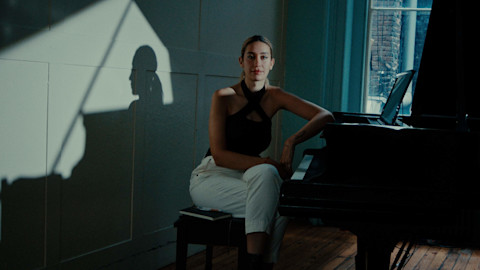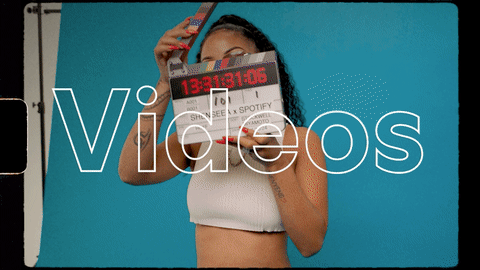Stories
Finding Your Audience: The Music and The Message

How crafting a personal aesthetic attracts a loyal audience.
This much we know: The internet has changed everything. The freedom of communication and the instantaneous exchange of information it enables continues to alter our modern landscape—and the effect this has on an artist is ever-evolving. Social media gives fans an unvarnished look into their favorite artists' lives, while music platforms like Spotify give artists unparalleled freedom to share their music with an ever-growing audience. But this flood of access comes with its attendant challenges. Artists have more competition than ever before. You need music and a message. You need an identity.
For artists, that identity comes in the form of a personal aesthetic. A great artist identity works much like a business: You establish a model that differentiates you from others, you present a clear message that can effectively attract a new audience, which in turn converts casual listeners to loyal fans. This strategy is more important than ever in today’s heavily saturated and competitive market.
Keep the customer satisfied
“Defining yourself and constructing a marketing plan around it will streamline the way you communicate as an artist,” says Jessica Hackett of digital music school Soundfly. That development and cultivation of a strong artist identity is another way of drawing fans and brands into your orbit. It’s a way to start conversations that may not have happened otherwise or, in the words of Hackett, a way to “help your content better resonate with your fans.”
Hackett may be speaking in a language more commonly found in a boardroom than a soundcheck, but the notion that musicians should bolster their art with business know-how is a salient one. A core audience—the ones that stream every album, pre-order concert tickets, watch every new video, shell out for the merch—are considered “repeat customers” in this construction, a key component to any company looking to maximize revenue.
Get in character
Lana Del Rey Take an artist like Lana Del Rey. She released music under her real name, Lizzy Grant, until 2010 when she took on her current moniker. This name was a conscious decision to embrace a certain identity. As she told Vogue UK in 2011: “I wanted a name I could shape the music towards. I was going to Miami quite a lot at the time, speaking a lot of Spanish with my friends from Cuba—Lana Del Rey reminded us of the glamour of the seaside. It sounded gorgeous coming off the tip of the tongue.”
The deliberately maudlin name change has proven to be a savvy decision. Del Rey's visual and lyrical brand of music often incorporates themes of old Hollywood glamour and heady, traditionalist ideas of femininity and sexuality. When Del Rey blew up in the mainstream music world, her orchestral ballads like “Video Games” were a perfect complement to her clearly defined aesthetic. It’s a phenomenon common to stars across genres. They’ve all created a compelling world and invited fans to stay a while, creating a crowd of diehards in the process.
Arcade Fire Canadian indie rockers Arcade Fire have spent over a decade creating a consistent aesthetic experience around their ornate live shows and wonderfully creative visuals. The band’s decision to hold shows at secret and intimate venues has given them something that many platinum-selling acts can’t duplicate: mystique. Fans are drawn into that mysterious aura and can’t help but stay in the band’s orbit for good.
Lady Gaga Lady Gaga’s early embrace of avant garde fashion and unorthodox visuals creates a theatrical, otherworldly, and unpredictable aesthetic, but her choices are also a conscious championing of the marginalized. It's a move that served the dual purpose of a mission statement and branding exercise. Gaga’s fiercely loyal fans identified with her immediately and haven’t let go since.
Pharrell Artist and mega-producer Pharrell has been developing his own identity since his days crafting futuristic beats as one half of The Neptunes. His streetwear line Billionaire Boys Club is going on two decades of trendsetting, and he’s created sought after collaborations with everyone from Louis Vuitton to adidas. The nexus of hip-hop and fashion has always been fertile ground for artists, but not many have been more successful at cultivating it than Skateboard P.
Finding the right partner
Fans aren’t the only population artists should be aiming to attract, however. Finding institutional partners and collaborators that mesh naturally with your well-honed image is a way to both amplify your visibility and broaden your income stream. Finding those opportunities is equal parts analysis and ambition. Artists need to do their homework; engaging with brands that are obvious square pegs will do more damage than good, while finding a partner that makes sense can create a career-spanning alliance that can lead to a steady source of revenue.
Stay true to yourself and your fans
Creating a universe based on your artistic identity that attracts both fans and potential collaborators isn’t done in a vacuum. You need to have an unalloyed vision of where you want to be and what you want to say. “Without a clear brand identity, you can become lost in the marketplace, like a tree without roots,” writes Bobby Borg in the book Five Star Music Makeover. “You’ll appear unpredictable—which customers recognize easily and use as a reason to withdraw their allegiance from you, or never to pledge their allegiance in the first place.” Your universe as an artist needs to have a gravity to it, otherwise you risk fans, brands, and collaborators simply floating by, taking their dedication and money with them.
Fans set adrift means fewer concert attendees, less traffic at the merch table, and lost revenue all around. Loyalty—from fans and partners alike—is what any artist should be striving for. It’s those “repeat customers” that let artists grow, thrive, and standout from the crowd, and those long-term relationships with like-minded brands that open up doors to new sources of revenue. Finding who you are is important. Finding what you mean is more than that: It’s vital.
—T.M. Brown
Spotify for Artists helps you to develop the fanbase you need to reach your goals.
video
How Julia Wolf Made It



